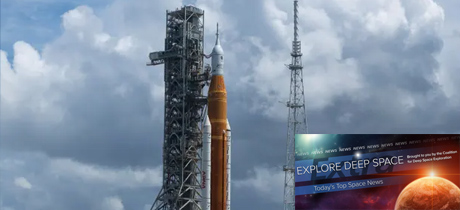Subscribe to our Daily Newsletter:
Don’t miss the latest developments in space policy, science, and exploration with Deep Space Extra, delivered directly to your inbox from Monday to Friday.
|
|
Here is a list of news that were published in our Newsletter the week of November 6-12, 2022:
Human Space Exploration:
- China scraps expendable Long March 9 rocket plan in favor of reusable version
- Heat shield that could land humans on Mars is hitching a ride to space
- NASA’s Artemis I Moon rocket boosters could expire in December, launch or not
- Cygnus cargo ship arrives at space station with only one working solar panel
- Tropical Storm Nicole forces another delay to Artemis I launch
- Cygnus cargo ship is trying to reach space station with only 1 solar array deployed
- NASA watching weather for Artemis I as Nicole threatens
- SLS returns to the pad for next Artemis launch attempt
- Antares launches Cygnus cargo mission to ISS
Space Science
- Right place, right time: Hubble captured a supernova as it exploded
- James Webb Space Telescope’s supercold camera bounces back from glitch
- No signs of alien life found near source of famous ‘Wow!’ signal
- Want a sneak peek from NASA’s Lucy mission? Photos it took of the Moon during its flyby
- NASA Mars rover may have a dust problem in its rock sample system
- Confirmed! A 2014 meteor is Earth’s 1st known interstellar visitor
- Astronomers have found the closest known black hole to Earth
- Psyche review finds institutional problems at JPL
- The origins of Mars’ crust might be surprisingly complex
Opinion
- Does the Moon mean Mars is next?
Other News
- Rocket Lab announces launch window for inaugural Electron mission from Launch Complex 2 in Virginia
- Atlas rocket bids farewell to California as ULA readies for Vulcan
- South Africa’s new ground station to help NASA track space flights
- DARPA’s robot could start servicing satellites in 2025
- NASA appoints James Kenyon as director of Glenn Research Center in Cleveland
- Space Force official: We need the Commerce Department’s space traffic office to be successful
- China completes test of liquid-propellant rocket engine
- Helicopter misses rocket booster in wild attempt to recapture it after flight
- Nelson chastises China for another uncontrolled rocket reentry
Major Space Related Activities for the Week
- NASA’s next attempt to launch the Artemis I test flight of the Space Launch System (SLS) and Orion crew capsule on an unpiloted test flight around the Moon and back to Earth. Launch is planned for 12:07 a.m. EST on November 14. A NASA briefing discussing the outcome of a pre-launch Mission Management Team meeting is planned for Friday about 7 p.m., EST, with a countdown update planned for Saturday at 12 p.m. EST. Live NASA coverage of the launch will begin Sunday afternoon. All the events will be broadcast on NASA-TV and streamed on www.nasa.gov/nasalive.
- Also on Sunday, the NASA-funded CAPSTONE mission, launched on June 28, is to enter a Near Rectilinear Halo Orbit around the Moon, a first. CAPSTONE will explore and assess the highly elliptical orbit that is to be home to the NASA led Gateway, a human-tended outpost supporting efforts to establish a sustained human presence at the Moon to prepare for human expeditions to Mars.
- A series of seven NASA and Russian spacewalks are planned outside the International Space Station (ISS) as 2022 winds down to continue an upgrade of the U.S. solar power system and continue integration of the Nauka multipurpose laboratory module into the ISS’s Russian segment. NASA hosts a news briefing on plans for its spacewalks on Monday at 2 p.m. EST.
- NASA also will brief on the science and technology planned for launch to the ISS aboard the next SpaceX resupply mission on Wednesday at 1 p.m. EST. NASA will televise and stream the science briefing. The launch itself is planned for no earlier than November 18.
- Also this week, NASA plans the launch of a NOAA polar orbiting weather satellite and a demonstration of LOFTID, a hypersonic inflatable aerodynamic decelerator, which is an aeroshell technology that could help humans land on Mars in the future. LOFTID will use the technology to attempt a soft landing after separating from the United Launch Alliance (ULA) Atlas 5’s Centaur upper stage. The launch from Vandenberg Space Force Base, California, is planned for Thursday at 4:25 a.m. EST. NASA TV coverage and streaming is to begin at 3:45 a.m. EST.

